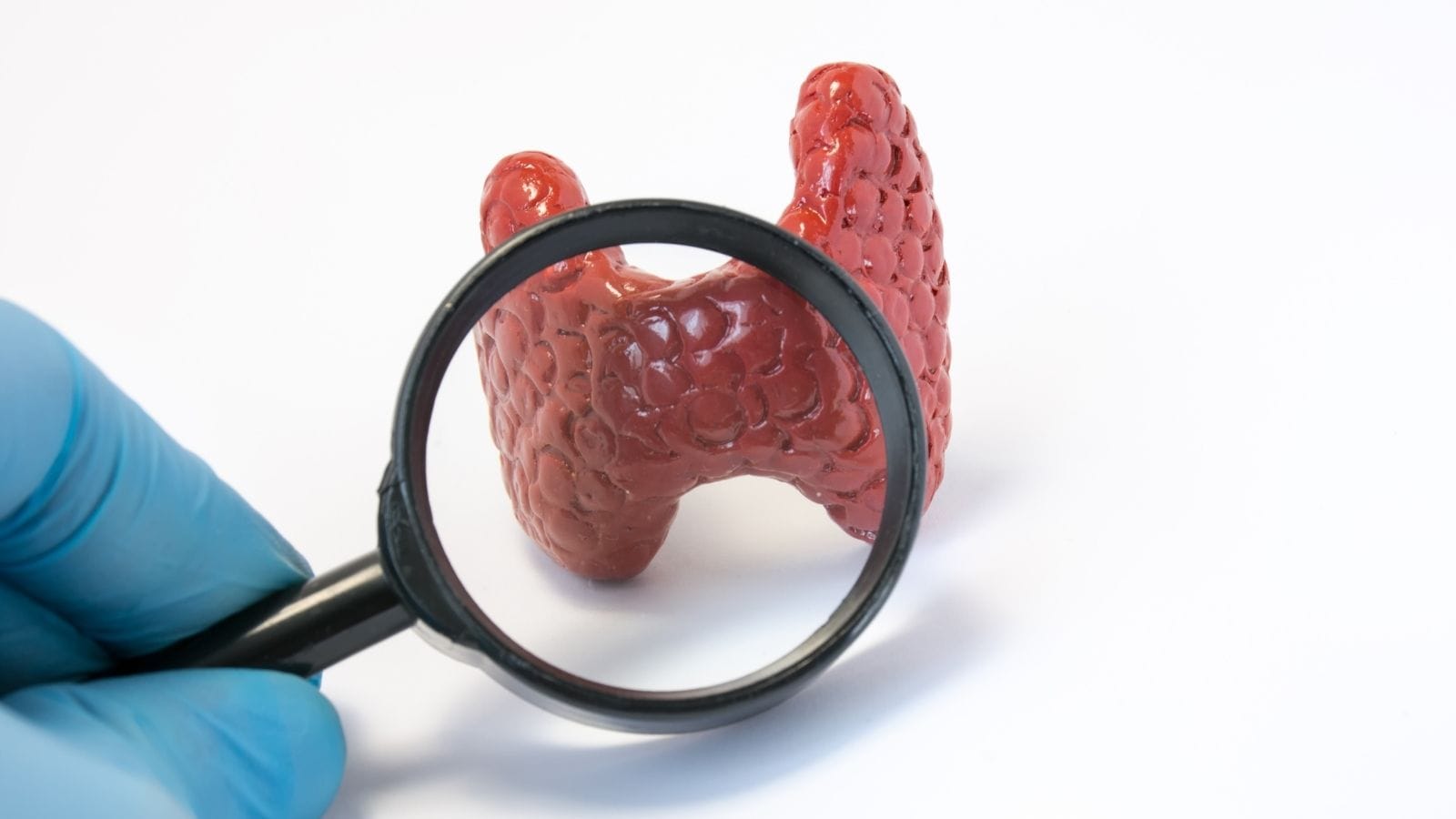Free T3 (triiodothyronine) is an active thyroid hormone that regulates metabolism, energy production, and organ function. Measuring free T3 helps assess thyroid activity more accurately than total hormone levels.
High free T3 levels are typically seen in hyperthyroidism. Symptoms include weight loss, rapid heartbeat, tremors, and anxiety, often related to Graves’ disease or toxic nodular goiter.
Low free T3 levels may occur in hypothyroidism, chronic illness, or malnutrition. Patients may experience fatigue, weight gain, cold intolerance, and mental slowing, requiring further diagnostic evaluation.
Blood testing of free T3 is usually combined with TSH and free T4 measurements. This comprehensive approach ensures accurate diagnosis and effective treatment planning for thyroid disorders.
| Medical Name | Free T3 (fT3 – Free Triiodothyronine) |
| Site of Production | Thyroid gland (partially), converted from T4 in peripheral tissues |
| Function | Regulates metabolic rate, affects heart rate and body temperature, increases nervous system activity |
| Clinical Uses | Evaluation of thyroid dysfunctions (hyperthyroidism/hypothyroidism) |
| Normal Reference Range | Usually 2.0–4.4 pg/mL (may vary by laboratory) |
| Causes of Elevation | Hyperthyroidism (Graves’ disease, toxic nodule), medications (amiodarone, T3-containing drugs) |
| Causes of Decrease | Hypothyroidism, fasting, severe illnesses, non-thyroidal illness syndrome |
| Test Preparation | No special preparation; all medications should be reported to the physician |
| Interpretation | Should be evaluated together with TSH and free T4 |
| Important Warnings | Not diagnostic on its own; should be interpreted with other thyroid tests |
What Is Free T3?
Free T3 is the unbound, active form of the T3 hormone produced by the thyroid gland. The thyroid produces two main hormones: T4 (thyroxine) and T3 (triiodothyronine). While T4 is produced in larger quantities, the most active form that enters cells and exerts effects is T3. Most T3 in the blood is bound to carrier proteins and is inactive. Free T3 refers to the small but effective portion that is unbound and biologically active.
What Is the Role of Free T3 Among Thyroid Hormones?
The thyroid gland, located at the front of the neck, produces T4 and T3. T4 acts as a storage or precursor hormone, which must be converted to its active form, T3, especially in organs such as the liver and kidneys. Free T3 is this active, unbound form, which binds to receptors in cells to exert the main effects of thyroid hormones. T3’s binding power to these receptors is much greater than that of T4.
Why Is Free T3 in the Blood Important?
Most thyroid hormones in the blood (>99%) are bound to carrier proteins, which serve as a reserve and are inactive. The unbound portion—Free T3 (FT3)—is the active form. Only this free form can enter cells to regulate metabolism, heart rate, and many other functions. Thus, measuring Free T3 is important for understanding the body’s true thyroid status.
How Does Free T3 Affect Metabolism?
Free T3 acts as the body’s energy power plant. It determines metabolic rate—how quickly the body converts food calories into energy. Changes in Free T3 levels directly impact weight gain or loss. It is also critical for maintaining body temperature and general energy balance. If Free T3 is normal, you generally feel energetic and your body temperature is stable.
Why Is Free T3 Necessary for Heart and Digestive Systems?
Free T3 not only affects metabolism but also the cardiovascular system. It regulates heart rate—high levels speed up the heart, low levels slow it down. It also affects the strength of heart contractions. Free T3 is needed for proper digestive system function, influencing gut motility and the speed at which food passes through the digestive tract.
What Role Does Free T3 Play in Muscle, Bone, and Brain Health?
Free T3 is important for proper muscle function and control. It is also critical for bone health—supporting bone growth in children and bone renewal in adults. For the brain, especially in fetal development, Free T3 is vital. Throughout life, it influences alertness, concentration, memory, and mood.
Does Free T3 Affect Other Body Functions?
Yes, Free T3 also affects skin health, hair and nail growth, stimulates red blood cell production (thus helping oxygen transport), and is important for reproductive health and menstrual cycle regulation in women. In short, Free T3 influences nearly every cell and organ in the body, so abnormalities can lead to a wide variety of symptoms.
How Is Free T3 Production Initiated and Regulated?
Production and release of Free T3 are tightly regulated by the hypothalamic-pituitary-thyroid (HPT) axis. The hypothalamus releases TRH, stimulating the pituitary to secrete TSH, which in turn stimulates the thyroid gland to produce T4 and T3. Adequate iodine intake is also essential for production. This system constantly adjusts to meet the body’s Free T3 needs.
Where Does the Body Obtain Most Free T3?
The thyroid gland produces some T3 directly (~20%), but most Free T3 (~80%) is generated from T4 conversion in peripheral tissues, mainly in the liver, kidneys, and muscles. This conversion, called deiodination, removes one iodine atom from T4. Thus, T4 serves as a raw material for active Free T3 production.
Are There Enzymes That Adjust Free T3 Levels?
Yes, specific enzymes called deiodinases regulate T4 to T3 conversion and thyroid hormone activity. D1 and D2 convert T4 to active Free T3, increasing hormone levels. D3 converts T4 to inactive reverse T3 (rT3), decreasing hormone activity. These enzymes allow tissues to regulate Free T3 levels according to need. Some drugs or illnesses can affect these enzymes.
How Does the Feedback System Maintain Free T3 Balance?
Free T3 and T4 levels are regulated by a “negative feedback” system. When levels rise above a threshold, the pituitary gland receives a signal to reduce TSH production, slowing thyroid hormone output. If hormone levels fall, TSH increases, prompting more hormone production. This precise balance keeps Free T3 within normal limits.
What’s the Difference Between Free T3 and Total T3 Tests?
Total T3 measures both protein-bound and free T3 in the blood. Free T3 tests measure only the unbound, active form. Free T3 better reflects the body’s true thyroid status, as it is not affected by changes in binding proteins (such as during pregnancy).
Which Is More Reliable—Free T3 or Total T3?
There is no universal answer; it depends on the situation. Free T3 is often more clinically relevant, but because its concentration is very low, measurement can be technically challenging. Total T3 tests may be more stable, but if protein levels are altered, Free T3 provides more accurate information. The best approach is to interpret results with TSH and FT4, guided by your doctor.
When Is Free T3 Most Commonly Tested?
Free T3 is most commonly ordered to diagnose or confirm hyperthyroidism, especially if TSH is low. Sometimes only Free T3 is elevated (T3 toxicosis) and FT4 is normal. It is also used to monitor hyperthyroidism treatment.
Is Free T3 Used for Hypothyroidism Diagnosis?
Usually not. In hypothyroidism, Free T3 is often the last value to fall. TSH (usually elevated) and Free T4 (usually low) are more sensitive for diagnosis. Free T3 can remain normal even in severe hypothyroidism.
What Is the Normal Free T3 Value for Adults?
Typical adult Free T3 range is approximately 2.0–4.4 pg/mL (lab methods and reference may vary). In pmol/L, this is about 3.1–6.8 pmol/L. Always check your own lab’s reference range for your results.
Why Do Normal Free T3 Ranges Vary?
Ranges vary depending on the assay method and devices used by the laboratory. Age is also a factor, with lower levels seen as age increases. Reference ranges for children, adults, and elderly differ.
Do Free T3 Levels Change During Pregnancy?
Yes, pregnancy changes Free T3 levels and reference ranges. Higher estrogen increases binding proteins, raising total T3 and T4. Special trimester-specific reference ranges should be used during pregnancy.
Do Diseases or Medications Affect Free T3?
Definitely. Severe non-thyroidal illness (NTIS), infections, heart diseases, major surgery, and many drugs (estrogen, some heart drugs, steroids, lithium, high-dose biotin) can affect Free T3 results. Always tell your doctor about all medications and illnesses.
What Does High Free T3 Indicate?
High Free T3 usually means an overactive thyroid (hyperthyroidism or thyrotoxicosis). Causes include Graves’ disease, toxic nodular goiter, or thyroiditis. Symptoms and risks may include weight loss, palpitations, tremors, nervousness, heat intolerance, and more.
What Are the Symptoms of High Free T3?
Symptoms: weight loss despite normal/increased appetite, fatigue with insomnia, heat intolerance, excessive sweating, fast/irregular heartbeat, tremor, anxiety, increased bowel movements/diarrhea, hair loss, thin skin. Eye changes (Graves’ disease) may also occur.
Possible Complications of High Free T3?
If untreated, high Free T3 can cause heart rhythm disorders (atrial fibrillation), heart failure, osteoporosis, and—in Graves’ disease—eye damage. Rarely, life-threatening “thyroid storm” may develop.
What Does Low Free T3 Indicate?
Low Free T3 may indicate hypothyroidism (underactive thyroid) or non-thyroidal illness syndrome (NTIS) in serious illness. In hypothyroidism, Free T3 is often the last to decrease, so TSH and FT4 are more useful for diagnosis. In NTIS, the underlying illness is usually the main concern.
Symptoms of Low Free T3?
If due to hypothyroidism: persistent fatigue, unexplained weight gain, cold intolerance, constipation, dry/pale skin, hair loss, memory/concentration issues (“brain fog”), depression, muscle/joint pain, slow heart rate, menstrual irregularities. In NTIS, symptoms relate to the underlying illness.
What Causes Low Free T3?
Most common cause: Hashimoto’s thyroiditis (autoimmune). Other causes: post-thyroid surgery or radioiodine therapy, certain medications (lithium, amiodarone), iodine deficiency or excess, congenital thyroid problems, pituitary dysfunction. In NTIS, cause is serious underlying illness. Your doctor will interpret this with TSH and FT4.

Interventional Radiology and Neuroradiology Speaclist Prof. Dr. Özgür Kılıçkesmez graduated from Cerrahpaşa Medical Faculty in 1997. He completed his specialization at Istanbul Education and Research Hospital. He received training in interventional radiology and oncology in London. He founded the interventional radiology department at Istanbul Çam and Sakura City Hospital and became a professor in 2020. He holds many international awards and certificates, has over 150 scientific publications, and has been cited more than 1500 times. He is currently working at Medicana Ataköy Hospital.









Vaka Örnekleri